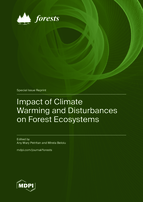Seed Harvesting and Climate Change Interact to Affect the Natural Regeneration of Pinus koraiensis
Round 1
Reviewer 1 Report
General comment
Sophisticated simulation research exploring the separated and synergetic effect of seed harvesting and climatic change on the regeneration, population dynamic and geographic distribution of Pinus koraiensis. Simulation was conducted coupling two process models that operates at different scales.
Although is a sophisticated, well documented and interesting simulation, at the core of such simulation, is the seed harvesting level variable. However, the introduction and methods lack a clear explanation of why seeds of this species are harvested, what is the amount produced in natural stands (20 to 30 seeds per hectare with potential for germination PER HECTARE sounds to me quite unrealistic -because too low), and what is the justification of using the given amount of harvesting defined as treatments in the simulations. All that need to be explained and justified to convince the reader that the author results are credible as a representation of something that likely might happen on the field.
Specific comments
Abstract
Lines 32-34. The first sentence “ Our study evaluated and quantified the effects of seed harvesting and climate change on the natural regeneration of Pinus koraiensis,” is already mentioned earlier in theAbstract. The second sentence, “.. and provided some insights for protecting and restoring the primary mixed Pinus koraiensis forests at the landscape scale”, lack the core of what you found, meaning, it does not say what are such insights. Instead of such three lines sort of repetitive and that provide no substantial information, better say your conclusions and/or be more specific about what are the insights that you found.
Introduction
Lines 45-46. Indicate why is such high “economic value of Pinus koraiensis seeds”. Because those are scarce for ecological restoration problems? ¿Because those are large seed, edible, as pinyon pines? No idea for an international audience no familiar at all with the species.
73-74. what do you mean with “Seed harvesting directly reduced seed sources”? That trees will reduce their seed production? Or do you mean that seed sources = provenances and because disappearance of populations there are less provenances from which collect seeds? Please clarify.
Methodology
121. What do you mean with “welfare” on “the special ecological welfare forests, the general ecological welfare forest..”.No clear at all. A forest whose main management objective is conservation?? Income for local people?
Table 1. Indicate what does mean those acronyms/codes of “DMX, DMN”, etc., either as a foot text of the table, or at its Table heading, or referring to other table?? The table need to be understandable by itself (self-explanatory). By the way: Degree days are > 5 oC?
Table 2. Same comment than for Table 1.
Table 2. Well, I have no idea how do you arrive to such number, but having 20 to 30 potential germination seeds per specie per hectare, it sounds to me quite unrealistic. Any seed rain study likely would indicate a much more larger number.
426-427. What d you mean with “provenance protection”? Biological conservation populations?
Author Response
Please see the attachment.
Author Response File: ![]() Author Response.docx
Author Response.docx
Reviewer 2 Report
Dear Authors
The manuscript is well written but needs some minor adjustment.
I doubt if your conclusions/predictions will be confirmed but I think your paper is technically fine!
Please find attached my suggestions.
Sincerely
Comments for author File: ![]() Comments.pdf
Comments.pdf
Author Response
Please see the attachment.
Author Response File: ![]() Author Response.docx
Author Response.docx
Reviewer 3 Report
I think it is important to reduce the text a little (in the entire manuscript), but mainly in the introduction and methodology. It's quite long, making reading tiring.Some changes are required and are indicated in the manuscript file. Figure 4 needs to be improved.
Comments for author File: ![]() Comments.pdf
Comments.pdf
Author Response
Please see the attachment.
Author Response File: ![]() Author Response.docx
Author Response.docx
Round 2
Reviewer 1 Report
The revised version improved significantly the original version, and clarified my main questions and concerns.
I might be needed only a spell checking by a native English speaker.
Author Response
Thanks for your comment. We have double checked the spells throughout the manuscript.





